 |
 |
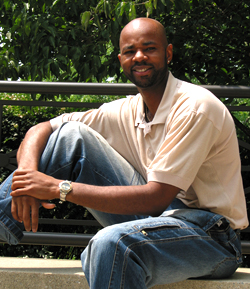
|
|
Milton English, Medical Scientist, Research Associate, National Human Genome Research Institute, NIH, Bethesda, MD
|
1. I chose this career because...
2. My typical workday involves...
3. My Tasks...
4. What I like best/least about my work...
5. My career goals are...
6. When I'm not working, I like to...
|
|
1. I chose this career because...
|
Back to Top

|
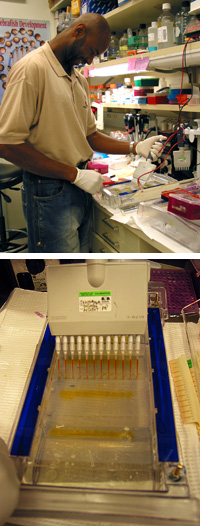
|
|
Milton loads DNA into the small wells of a gel (top) and uses an electrophoresis apparatus (bottom) to separate the DNA particles by size.
|
I chose to become a medical scientist because my childhood interest in science was heightened throughout my education. I grew up with my grandparents in Guyana, South America. We had a lot of livestock including cows, chickens, pigs, and donkeys. My chores included taking care of the animals. I even witnessed some of them giving birth. I was awed by the experience and it made me curious about what was going on inside of them. I always wanted to learn more.
When I was 16, I came to the United States and lived in Brooklyn, New York, where I finished high school. There were two things I found surprising and interesting. It was the first time I saw snow. I was amazed at the sight. The other surprise was when the leaves of the trees started to bloom in Spring. During the winter months, I kept telling my mother that those trees were dead. She told me they would come back, but I didn’t believe her until I saw it for myself.
Ever since I was in Guyana, I wanted to know what happened inside the body. In high school, I remember that we did a very basic experiment that brought my interest to a new level. We pricked our fingers and made blood smears. After staining them, we looked at them under the microscope and I could see all the different types of blood cells. I totally loved it. From that point on, I knew I wanted to be a doctor and surgeon. At the time, I liked the idea of cutting things open to see what was inside.
Later in college, two of my classes helped me realize that there was an alternative to surgery as a way to learn more about the inner workings of the human body. The first class was in biochemistry. In one experiment, I learned about restriction enzymes that are used to cut Deoxyribonucleic Acid (DNA) in specific places. The teacher said the enzymes were like “molecular scissors.” I was awed that you could have genetic material and enzymes in a little tube.
In my biotechnology class, we did an experiment with bacterial cultures. We treated one culture with a compound known to increase and decrease the expression of some genes that code for proteins in bacteria. The other culture was left untreated. Then we grew the bacteria for several hours, and isolated proteins from each culture. The proteins were separated on a gel. When we compared the proteins from the treated cultures versus the non-treated, you could see the different protein bands on the gel. This was an incredible experience for me. It made me want to learn more. I wanted to understand exactly how this compound could turn some genes on while turning others off. Later, I found out that the whole process was called “gene regulation.”
College Education
- Doctor of Philosophy (Ph. D), Molecular, Cellular, Biochemical and Developmental Sciences, Mount Sinai Graduate School of Biomedical Sciences of New York University (http://www.mssm.edu/gradschool/), New York, New York
- Master of Science, Biology, Mount Sinai Graduate School of Biomedical Sciences of New York University, New York, New York
- Bachelor of Science, Biology major, Chemistry minor, State University of New York at Cortland (http://www.cortland.edu/), Cortland, New York
|
|
2. My typical workday involves...
|
Back to Top

|
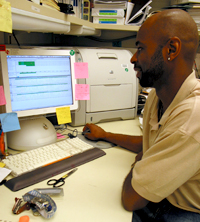
|
|
Milton isolates a gene of interest, and compares it to an online database of the entire zebrafish genome to see where it fits.
|
My typical workday involves doing research on a line of zebrafish that have no blood. My research focuses on finding the gene that is responsible for the bloodless phenotype (or observable characteristics) seen in this mutant line of zebrafish. My own research is part of a much larger project that aims to better understand blood cell development (or hematopoiesis) in humans. With a greater understanding, we may be able to develop better diagnostic tools and treatments for human diseases affecting blood cells such as diabetes, hemophilia, anemias, and various leukemias. Zebrafish are perfect for this project because they have the same types of blood cells as humans. Their development is external and the embryos are transparent, which allows me to observe the blood cells under a simple dissecting microscope.
|
|
3. My Tasks...
|
Back to Top

|
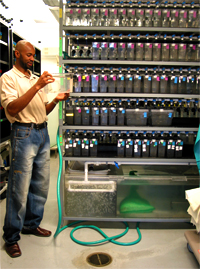
|
|
Most of Milton's experiments begin with a trip to the "fish room" - a special environment to maintain multiple rows of zebrafish chambers.
|
My tasks in the laboratory include:
- Breed zebrafish carrying genes of interest for the study
- Isolate deoyribnucleic acid (DNA) from the fertilized zebrafish embryos
- Complete a polymerase chain reaction protocol (a process that amplifies a region of DNA containing the gene of interest)
- Examine the DNA samples using gel electrophoresis (an apparatus that separates DNA particles by size)
- Compare study samples to an online database of the whole zebrafish genome
In the afternoons, I set up breedings between fish that have a genetic characteristic we want to study. Using Gregor Mendel inheritance basics, we can calculate ahead of time that 1/4th of the offspring (fertilized embryos) will have two copies of the mutated gene being studied. I put a single male and female fish together in a special breeding chamber. The breeding chamber has a mesh screen across the bottom that allows the fertilized embryos to pass into an isolated chamber below. If they were kept in the same chamber, the parents may eat them. The next morning, I check the chambers to see which fish bred, and collect the embryos.
Twenty-four hours after fertilization, I isolate DNA from the embryos and complete laboratory procedures (such as gel electrophoresis), to ensure the genes of interest are present. At this point, I spend a lot of time comparing my data to the DNA sequences of zebrafish available online. I am looking to see where my isolated genes fit into the whole genome.
|
|
4. What I like best/least about my work...
|
Back to Top

|
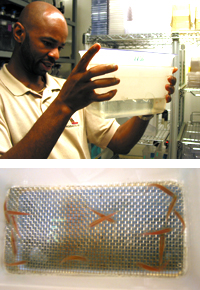
|
|
Milton examines a zebrafish breeding chamber (top). Zebrafish embryos pass through a mesh screen and collect in the bottom of the chamber, while adult fish remain above (bottom).
|
What I like best about my work is that it is like detective work. In my project, for example, we know that genes are mutated. Our challenge is to figure out which ones. I always use an analogy to explain my research. Imagine you are looking for someone (or a gene) and all you know is that the person in on the earth. Where do you start? You do a couple of tests and find out which continent the person is on (North America, for example). The continent is like the chromosome. Once we know the continent (or chromosome) we do more tests and narrow it down to the country (the United States, for example). The country is like a general region on the chromosome. Eventually you can get down to an exact address, which is like finding the exact gene of interest. The detective work is very rewarding and it is also never ending. Once you answer one question, there are always more questions to ask and more answers to find.
What I like least about my work is the frustration when things don’t always work like they are supposed to work. You may follow a series of steps (or a protocol) a thousand times and it works fine. Then one time it does not work. You have to spend some time troubleshooting the technical problem. It might be as simple as contamination in the water sample. These problems can hinder the research aimed at answering much bigger questions that relate to human health.
|
|
5. My career goals are...
|
Back to Top

|
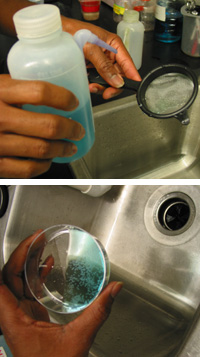
|
|
Milton collects embryos from the breeding chambers, rinses them (top) and transfers them to a clean Petri dish (bottom) for further examination under the dissecting mircroscope.
|
My career goals are to continue in my research at the NIH and eventually have my own lab. I have always wanted to do research in gene regulation and cancer. In the future, I would like to have my own lab and study cancer, cell growth and regulation. In addition, I have always felt strongly about mentoring. I didn’t have the exposure to the possibilities in science when I was growing up. Since working at the NIH, our lab has always had summer students, and I act as their supervisor and mentor. Though I don’t expect them all to become scientists, it gives me a lot of satisfaction to show them the opportunities in research.
|
|
6. When I'm not working, I like to...
|
Back to Top

|
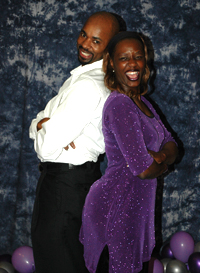
|
|
| |
Milton and his dance partner, Lisa Lawson
|
When I’m not working, I like to dance, usually 4 to 5 times a week in the evenings. I am a member of a hand dance team that performs locally http://www.smoothnez.com/. Hand dancing is the official dance of Washington, D.C. See a video of Milton dancing in a 2007 performance, http://www.youtube.com/watch?v=9wagm9ZtDX4.
I am also an exercise nut and go to the gym almost every day. At home, I enjoy growing orchids, and currently care for about two-dozen plants.
|
|
|
|
 |